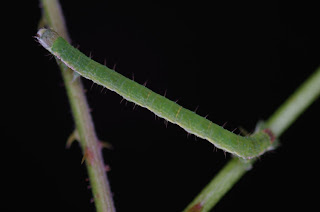I was really excited when I came downstairs this morning and saw this, because of the 25 or so caterpillars that have chrysalized in my dining room this summer, I have not seen any of them undergo the transformation from caterpillar to pupa. It is a process that happens pretty quickly, so if you don't happen to see it at the start, you will probably miss it. I caught the tail end of the process once this summer, and have seen a few just after they finished, but I thought that today I finally had the lucky timing. I ran to get my camera, and took a couple of pictures, but the process did not continue to develop before my eager eyes. I realized that the caterpillar was not continuing to shed its skin. It was just hanging there, and in order to shed its skin it would have to be wriggling pretty vigorously. The skin had split, and then... Nothing else happened. I waited a few hours, during which nothing changed, and then removed it from the butterfly enclosure. I don't know what caused this to happen, but I don't want it to affect any of the remaining pupae and caterpillars in any way, whether there is to be a parasitic wasp emerging, or the caterpillar suffered from some disease. This is one of the caterpillars I adopted just a couple of days ago at nearly the end of its caterpillar stage. I have no idea what it may have been subjected to before then. I feel sad about this, but I have to remind myself that of the 25 caterpillars that have developed into chrysalides so far in my house, including 10 that have already been released as butterflies, in all likelihood 23 of them would not have made it so far out in the cruel world of nature.
Backyard Bug of the Day:
Weevil. I wasn't able to figure out what species from the books, but it is a "true weevil," based on the long snout with the bent antennae. I am cheating a little bit here because this picture was taken of the weevil on the ground in the street in front of my house, so technically not in my yard, but it was in my yard when I first spotted it, it just did that annoying weevil thing of rolling off the plant it was on to avoid having its picture taken.
In this terrible picture you get a better look at the snout/antennae combo.
Other Bugs:
This katydid is on some kind of animal droppings on my front walk.
There are still a lot of caterpillars around:
Either this is a different eastern tiger swallowtail caterpillar than the one I have been watching for the last week, or it made an impressive hike to another branch of its tree since yesterday.
Today I spotted the viceroy caterpillar eating, which is the first time I have seen it do anything other than sit around on its leaf since I first saw it over a week ago. It's impressive that it has managed to grow and develop so much without appearing to eat at all (yes, I am sure it has been eating, but it gives the impression that it doesn't).
And speaking of eating...
Hey, that is MY broccoli! Caterpillars have destroyed the broccoli and Brussels sprouts in the garden.
A pair of jagged ambush bugs on goldenrod. The male has some prey in its clutches, but it doesn't look like it is actually feeding; I don't see its proboscis.
It was getting on toward evening when I did my bug walk, and clouding over, so it was dark and kind of chilly. The golden rod, instead of being full of a lot of lively insects, were covered with a lot of stuporous bumblebees.
This tiny moth is another big fan of goldenrod.
Red-banded hairstreak butterfly
Stinkbug
Hopper
Leaf-footed bug
.
.
.
.
.
.
.
.
.
.
.
.

















No comments:
Post a Comment